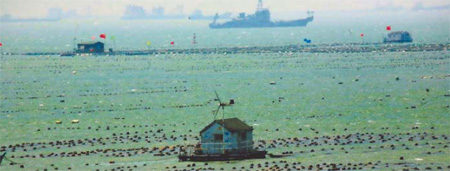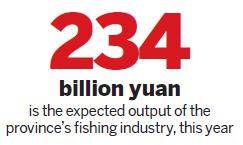|
|

A sea farm in Shandong province, a leading aquatic produce center. Ju Chuanjiang / China Daily |

Many people believe that that seafood is nutritious and healthy, so ocean fishing is expanding and an efficient, modern fishing industry has played an important role in Shandong province's economy over the last four years.
The province's total aquatic output is expected to reach 7.7 million tons this year. And the fishing industry's total output is expected to be worth 234 billion yuan ($35 billion), an increase of 12.7 percent over 2009.
The province has 1,000 fishing boats, producing 180,000 tons of fish annually, and generating 2 billion yuan in revenues.
The output value of sea cucumbers, abalone, prawns, crab, scallops, bass, and kelp accounts for 45.3 percent the province's total fish output.
At the same time, freshwater fisheries, with an annual output of 1.4 million tons, and 16 billion yuan in revenues, are becoming an important source of rural income.
Shandong's processing of aquatic products has made it China's biggest processing and exporting center. And the foreign trade in seafood is increasing annually. This year it is expected to reach 2.35 million tons and to be worth $6.2 billion.
Over the past five years, the government has approved 135 fishery projects, involving more than 6 billion yuan in investment. And 169 demonstration zones have been built on a 265,000-hectare area for pollution-free cultivation.
There are 610 companies in the fishing business, 82 of which famous brands like Homey Group and Oriental Ocean.
Featured local specialties like Jiaodong sea cucumber and steamed crab have had increased market appeal in the past five years.
Technology is supporting the fishing industry development, with 60 breeding centers and other programs producing new varieties.
There are also 25 provincial and State-level maritime libraries.
Since 2006, Shandong has won 140 provincial level awards, one national science and technology first prize, two technological invention second awards, and seven science and technology progress awards.
Shandong is also China's first province to come up with a fishing resources restoration plan. Over the past five years, it has spent 1.2 billion yuan on restoration to provide young fish, prawns, and jellyfish.
Several dozen fish preservation areas have been built on a 200,000-hectare area.
And it is combining this with marine eco-tourism and the leisure business, with 110 provincial level leisure fishery bases that receive 20 million tourists annually, and generate 4 billion yuan.
Five million people now work in the fishing industry and the income of the average fisherman has reached 10,000 yuan, a year-on-year increase of 6.8 percent.
By Cui Xiaoqing (China Daily)
(China Daily 12/21/2010 page6) |